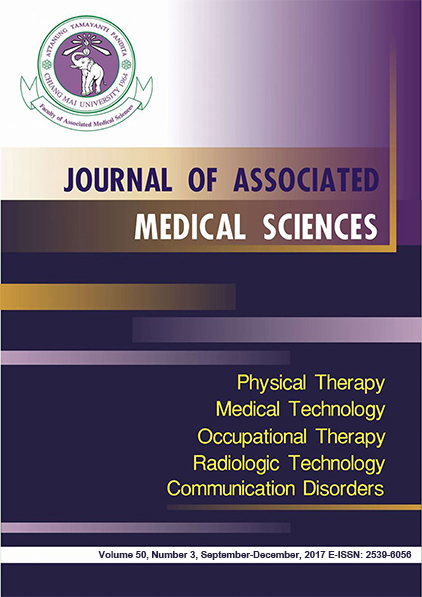Digital thickness meter using infrared sensor
Main Article Content
Abstract
Introduction: Knowing of patient thickness helps to determine the proper current and voltage of x-ray tube. Lesions on radiographs can be clearly seen and provide an accurate diagnosis. Implementation of microcontrollers and infrared sensors for digital thickness measurement can reduce time spending in thickness measurements providing a convenient way to measure the thickness without touching patient.
Objectives: Purposes of the study was to design and create a digital patient thickness meter using infrared sensor. Digital display provides an accurate and precise reading value. It was easily used, real time measurement, and touchless method.
Materials and methods: Digital thickness meter was calibrated and tested for the efficiency. Three different measurements of body’s thickness were compared. These values were measured from a traditional method using caliper, digital thickness meter, and digital thickness meter with a volunteer holding a smooth board.
Results: The result showed that digital meter has an error of 6%. There was a linear relationship between thickness values measured from calipers, digital meter (R²=0.7993 and digital meter with holding a smooth board (R²=0.8756). Statistical analysis showed that there was a significant difference between the thickness from caliper compared to digital meter with holding a smooth board (p<0.05). Thickness measurement in male volunteers provided more accurate result than female. Use of digital thickness meter with holding a smooth board was more accurate than using digital thickness meter alone.
Conclusion: Digital thickness meter using infrared sensor is a cheap, lightweight, and touchless measurement. However, the precision and accuracy of meter depend on the efficiency of infrared sensor which is a reflection property and surface absorption of material. Moreover, movement and breathing of volunteers affect the accuracy of measurement.
Article Details
Personal views expressed by the contributors in their articles are not necessarily those of the Journal of Associated Medical Sciences, Faculty of Associated Medical Sciences, Chiang Mai University.
References
2. Mahidol University. Chapter 3: exposurefactor. MTRD310.[updated 2012 Aug 06; cited 2016 Sep 17]. Avialable from: http://www.mt.mahidol.ac.th/e-learning/MTRD310/web/exposurefactor/2_3intro&mA.htm (in Thai).
3. Petcharakorn Hanpanich. Factors affecting the quality of radiography : Electric potential.[ cited 2016 Sep 17].Avialable from: gotoknow: https://www.gotoknow.org/posts/588617 (in Thai).
4. Suchart Kiatwattanacharoen. X-ray machines. [ cited 2016 Sep 16]. Avialable from: http://www.med.cmu.ac.th/dept/radiology/324321%5Cx_ray_vet321_55.pdf (in Thai).
5. Ampolpoj Wongpeum, Itt Subinmongkol, Somlak Jamroonsai, Sararas Intarak. The Measurement of Shoulder Soft Tissue Thickness by Using Chest Radiographic Image. Radiological Technology: Golden Jubilee Medical Center (in Thai).
6. Rhuta Marathe, Amruta Kulkarni, Utkarsha Devkar. Portable automatic height detector. International Journal of Science, Engineering and Technology Research (IJSETR). 2014; 3(10): 2693-8.
7. Sastrawut Thammakittiphan. Optimum kVp and mAs for Chest X-RAY Using Least Square [Thesis]. Medical Instrumentation: King Mongkut’s University of Technology North Bangkok; 2007 [cited 2016 Sep 20]. Available from: http://www.gits.kmutnb.ac.th/ethesis/data/4740381019.pdf (in Thai).
8. Panatsada Awikunprasert, Onuma Wayopat, Thunyarat Wongke, Theerayut Charnnuwong, Petcharakorn Hanpanich and Chayanon Awikunprasert. Performance of Infrared Sensor and Ultrasonic Sensor for Medical Applications. Srinakharinwirot Science Journal 2016. 33(1); In Press (in Thai).
9. Nakasuto. Infared light. [cited 2016 Oct 24]. Available from: http://nakasut007ster1234.blogspot.com/2006/12/infared-light.html (in Thai).
10. Mustapha B, Zayegh A, Begg RK. Ultrasonic and Infrared Sensors Performance in a Wireless Obstacle Detection System. First International Conference on Artificial Intelligence, Modelling & Simulation; Washington, DC, USA: IEEE Computer Society Washington, DC, USA. 2013. p. 487-92


